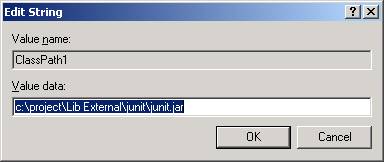
Java
Registry Settings
JVM Performance Tuning
In order
to run applications written with the Droplets Platform's Java SDK, the
machine on which your Droplets Server is running must also have Java support
as outlined in this section.
Specifically,
y
Information on the JVM (as well as
all Java-based Droplet applications) must also be entered into the registry:
The
following JVM configuration parameters may be specified in the registry
as well — only the
JVM parameter
is required. All
of them are string values underneath the SOFTWARE\Droplet\DropletServer\Java
key:
JVM (required) The full path to the JVM DLL that you wish the Droplets Server to use to run Java applications. The specified JVM must fully support the JNI 1.2 specification.
The registry key HKEY_LOCAL_MACHINE\SOFTWARE\Droplet\Droplet Server\Java contains an absolute path to the JVM DLL. For the Sun JDK 1.3, the Classic JVM is in JDK_HOME\jre\bin\classic\jvm.dll and the Hotspot Client JVM is in JDK_HOME\jre\bin\hotspot\jvm.dll. In JDK 1.4, there is no Classic; use JDK_HOME\jre\bin\client\jvm.dll for Hotspot Client, or JDK_HOME\jre\bin\server\jvm.dll for Hotspot Server.
The default value for JVM is determined by the installer.log-jvm-messages This indicates whether messages that the JVM generates should be written to the Droplets Server's log.
You should specify either "true" (it should be written to the Droplets Server log) or "false" (it should not).
jvm-options A list of options that will be passed directly through to the JVM. Separate the options by spaces, as you would on a command line. The possible options and their meaning is up to the particular JVM, but there are some standard options that all JVMs are required to support. See the JNI 1.2 specs for details.
See JVM Performance Tuning below to learn how to use this registry key to improve the performance of your JVM with the Droplets Server.
Default: empty
ignore-unrecognized-options This specifies whether the presence of an option that is unrecognized by the JVM should be considered a fatal error. A fatal error will cause the loading of all Java applications into the Droplets Server to fail.
You should specify either "true" or "false" for this key name. By default, its value is "true".
Note also that there is a bug in the Sun classic version of JVM (as of 1.3.0) that causes the ignore-unrecognized-options parameter to be interpreted as false even if you set it to true. Thus, with that Virtual Machine, you must always make sure not to provide any JVM options that the JVM does not recognize, regardless of what you set this parameter to.
stdout-file Specifies the file to which the JVM's standard output stream will be redirected — in other words, where System.out.println() will end up. stderr-file Specifies the file to which the JVM's standard error stream will be redirected — in other words, where System.err.println() will end up.
To
register Java applications and classpaths, enter registry keys under:
HKEY_LOCAL_MACHINE\SOFTWARE\Droplet\DropletServer\Java
By the name of:ClassPathX
ClassPathY
etc.
and
ServerX
ServerY
etc.
If you choose to use numbers to identify your classpaths and servers (i.e. ClassPath0, ClassPath1, etc.), then the numbers must start with 0 and and move up in order (0,1,2,3). You are not, however, restricted to using numbers to identify your classpaths and servers; for example, you could use your application names if desired (ClassPathHelloWorld, ClassPathDirectMessenger, etc.).
-
It must be the fully qualified name of a Java class that can be found in the CLASSPATH. Use slashes as package name delimiters (e.g. “com/droplets/hello/HelloAppFactory”, not “com.droplets.hello.HelloAppFactory”
-
The specified class must implement the com.droplets.api ApplicationFactory interface and have a default (no-argument) constructor.
If your Droplet is not loading, check the Platform log for details.
JVM Performance Tuning
The Droplets UI Server currently supports the Sun JDK 1.2, 1.3 and 1.4 JVMs in either Classic or HotSpot Client variety. Sun's HotSpot Server JVM is supported only in JDK version 1.4, and JRockit is currently not supported. It is highly recommended that in all Droplets deployments you use the HotSpot version of the JVM, as it results in much higher, more efficient JVM performance.
Performance tuning of the JVM which works in conjunction with the Droplets Server is highly recommended for enterprise deployments as the JVM is otherwise forced to reallocate memory for each user. JVM performance can be tuned with regard to the initial and maximum memory heaps which are allotted by the JVM. By default, the initial heap size for a Sun JVM is 1 megabyte in JDK 1.2 and 2 megabytes in JDK 1.3 and above, and the maximum heap size is 64 megabytes. You can improve JVM performance with Droplets by overriding these defaults using the "jvm-options" string within the HKEY_LOCAL_MACHINE\SOFTWARE\Droplet\Droplet Server\Java registry key as shown below:
Initial heap size -XmsNUMBER Maximum heap size -XmxNUMBER
NUMBER will be a number followed by an optional multiplier. The multiplier can be:
g (for gigabytes)
m (for megabytes)
k (for kilobytes)
For example, -Xms250m -Xmx500m would set the initial heap size for the JVM to 250 megabytes and a maximum heap size to 500 megabytes. If no multiplier is specified , it is assumed that the number represents bytes.
Recommendations
Initial heap: You should set a higher initial heap size than is created by default if you expect your Droplets Server to handle 200 or more simultaneous connections.
Maximum heap: You should always specify a maximum heap so that the Droplets Server is aware of how much memory has been allotted to the JVM. The ideal heap size varies depending on the applications which your server is hosting; if, for example, you have a Droplets Server supporting 500 or more simultaneous users, you will probably need at least 200m of memory allotted to the JVM.
